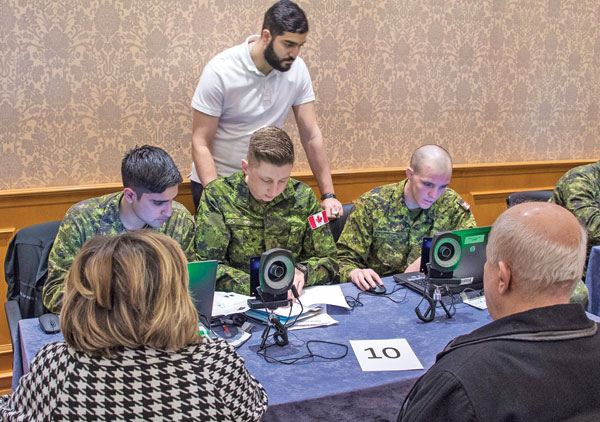Army reservists welcome refugees
By Lookout on Jan 04, 2016 with Comments 0

Members of Joint Task Force Forward, operate the bioscan systems for processing refugees in Beirut, Lebanon, during Operation Provision.
Steven Fouchard, Army Public Affairs >> As the first Syrian refugees arrive in Canada, Army Reservists are on the ground and eager to help keep them safe and comfortable while they await permanent resettlement in their new home.
The reservists have volunteered to be part of Operation Provision, the Canadian Armed Forces’ (CAF) contribution to the resettlement initiative, which is being led by Immigration, Refugees and Citizenship Canada (IRCC).
Most are serving in auxiliary security roles or augmenting staff on the various CAF bases where refugees may be temporarily housed should the need arise. Several say they feel a personal connection to the mission.
“I signed up for Op Provision because I wanted to welcome the Syrian refugees to Canada,” said Gunner Markus Hale, a member of 56 Field Regiment, Royal Canadian Artillery (RCA), based in Brantford, Ontario. “As an immigrant and a Canadian soldier, I felt it was my duty to volunteer.”
“I joined Op Provision because my parents were refugees to Canada and had a better life,” added Corporal Dardal Malushaj, with the Toronto Scottish Regiment. “I want to give back and help the Syrian refugees have a better life as well.”
Canada’s resettlement plan will continue to evolve as it moves forward. CAF members have both the training and high level of readiness needed to evolve with it.
The multi-faceted resettlement plan starts with the identification and processing of the approximately 25,000 displaced Syrians that IRCC estimates Canada will be taking in. A contingent of CAF members are deployed in Lebanon, Jordan and Turkey to assist.
According to IRCC, the 25,000 were to be identified by Dec. 31 and the expectation was that 10,000 of those would be welcomed to Canada by the end of 2015. The remaining 15,000 are expected to arrive by the end of February 2016.
Refugees are travelling on commercial airliners, the most efficient and affordable option, but Royal Canadian Air Force officials have a plan in place to provide additional airlift support every 48 hours as needed.
The CAF has the capacity to temporarily house as many as 6,000 refugees in Ontario and Quebec, and a further 7,000 elsewhere in Canada, if necessary. Most of the facilities that have been identified for possible use as temporary housing are Canadian Army. They are: Canadian Forces Base Kingston, Garrison Petawawa, and the 4th Canadian Division Training Centre (Meaford), all located in Ontario.
In Quebec, personnel at the 2nd Canadian Division Support Base in Valcartier and the 2nd Canadian Division Support Base in Montreal are ready to receive refugees if called upon.
Should they be needed, CAF personnel will be drawing on the experience of Operation Parasol, which included housing refugees from the Serbian province of Kosovo in 1999.
Approximately 5,000 people fleeing fighting in the region stayed for three months at various CAF facilities in Ontario (the Canadian Forces bases at Trenton, Kingston and Borden, Ontario) as well as Nova Scotia (the Canadian Forces Bases at Halifax and Greenwood, and Canadian Forces Station Aldershot) and New Brunswick (5th Canadian Division Support Base in Gagetown).
CAF personnel were also involved in large-scale operations supporting refugees from Vietnam. During Operation Magnet, as it was named, they oversaw the airlift and resettlement of more than 50,000 Vietnamese refugees between 1978 and 1981 following the fall of the South Vietnamese government.
Master Bombardier Jeff Roos, a reservist with 56 Field Regiment, RCA said he chose to join Op Provision to honour that legacy and to pass his knowledge and experience along to his younger comrades.
“I volunteered to go on Op Provision as it’s an excellent chance to welcome people from a war-torn part of the world to our peaceful country,” he said. “I wanted to continue to carry on the Canadian Armed Forces legacy in helping refugees as well as mentoring and developing younger soldiers to be as effective as possible.”
Filed Under: Top Stories
About the Author:





